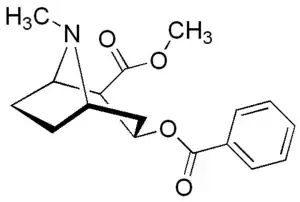Cocaine
Cocaine is a hell of a[1] drug refined from the coca plant specifically Erythroxylum coca var. coca. In its refined form, it presents as a white powder at one end of a rolled-up hundred dollar bill, of which the other end is inserted in one's nostril. As shocking as it may seem to stick a $100 bill up one's nose, if you've reached the point where you're doing cocaine, you've probably left such sensibilities behind.
| Our secret stash of Drugs |
| Highs and lows |
v - t - e |


Ingestion of cocaine results in euphoria, general power-tripping, but, sadly, eventual psychosis. According to a scale published in The Lancet, Cocaine works out as the second most harmful and second most addictive drug out of the major controlled substances in use around the world — second only to heroin.[2][3] You know, instead of meth.
Crack cocaine
Crack cocaine is a form of pre-processed freebase cocaine, in which the cocaine has been cooked with chemicals including sodium bicarbonate (baking soda). Since it becomes insoluble, it is smoked rather than snorted. In this form of cocaine, the drug has undergone freebasing (it removes the hydrochloride base from powdered cocaine)[4] and derives its name from the cracking noise that one hears when producing it.
The "poor person's drug"
Crack cocaine is generally considered a poor person's drug; it is fairly inexpensive compared to powdered cocaine and first rose to popularity in the inner cities of the United States in the mid-1980s. Though a dose of crack cocaine has roughly the same potency as the equivalent of powdered cocaine, in the US at least penalties for crack dealing and possession are substantially higher than those for powder cocaine, worsening already disproportionate representation of black and Hispanic minorities in the US prison population. The disparity was introduced in 1986 as a 100:1 ratio in which 50 grams of crack or 5,000 grams of powder cocaine would trigger a 10-year penalty; this was later reduced to an 18:1 ratio.[5]
Crack has also been blamed for an even further decline of the already poor and economically depressed inner cities, due to gang activity allied with organized crime both inside the US and from Latin America.[citation needed] Some community activists have gone so far as to concoct conspiracy theories blaming the United States Government, especially the CIA, for introducing crack to the inner city populations in a backdoor attempt to reintroduce a Jim Crow-like society.[citation needed]
The phenomenon of "crack babies," children born in poverty to mothers with cocaine addictions, was feared to be a major public health problem in the 1980s. While many — perhaps even most — such children had far fewer developmental problems than were feared, they remain a symbol of the potential hazards of drug abuse and poverty.[citation needed]
More addictive?
Since crack is smoked rather than snorted, the drug is absorbed into the bloodstream more rapidly. This causes a quicker "hit," and causes, according to the ruling opinion, a stronger psychological association between the act of smoking and the onset of the drug's euphoric effects since less time passes between the two.[6] Furthermore, the effect of crack is perceived much more intensely, because the hit itself feels very good. Sometimes it is described, as feeling like a complete other drug than normal cocaine.
However, this claim has been challenged, at least in the academic press. Morgan and Zimmer wrote that available data indicated that "…smoking cocaine by itself does not increase markedly the likelihood of dependence… The claim that cocaine is much more addictive when smoked must be reexamined."[7]
"Alternative" uses
Cocaine can also be used as a local anesthetic. If your tooth hurts, get a little and rub it your gum, while waiting for your dentist appointment.
Once upon a time, the "real" Coke (Coca Cola) truly was "the pause that refreshes." since its active ingredients were cocaine and the kola extract, caffeine. Bottles of the "real Coke" are now most likely held in private collections, much as old bottles of wine, or classic stashes of chronic, to be gently consumed and enjoyed by connoisseurs.
Cocaine (or, in reality, the raw leaf of the coca plant) is also known as Bolivian Marching Powder.
Legal status
Because cocaine does have valid medical uses as an anesthetic, it falls under Schedule II of the U.S. Controlled Substances Act: recognized medical uses, but a high potential for abuse.
Interestingly, marijuana falls under the even-more-restrictive U.S. Schedule I, supposedly reserved for substances with no recognized medical use and a high potential for abuse. Evidently, cocaine's use as a topical anesthetic is Federally recognized, but marijuana's use as an anti-nausea treatment is not.
This situation is reversed in Canada. Under Canada's Controlled Drugs and Substances Act, cocaine is listed alongside Rob Ford heroin and methamphetamine on the most restrictive Schedule I, while Schedule II is a special category containing only marijuana and nothing else. At least untill 2018, when Marijuana was legalized, leaving Schedule II empty for now.
See also
References
- Cocaine is a hell of a drug Urban Dictionary
- Development of a rational scale to assess the harm of drugs of potential misuse. (2007)
- Visualization of the scale
File:Wikipedia's W.svg - Ask Erowid
- Steiker, Carol (2013) Lessons from Two Failures, Duke University
- Crack vs Cocaine: Ingredients, Effects, Users & Crime Stats
- Morgan, John P.; Zimmer, Lynn (1997). "Social Pharmacology of Smokeable Cocaine". In Reinarman, Craig; Levine, Harry G.. Crack in America: Demon Drugs and Social Justice. Berkeley, Ca.: University of California Press.